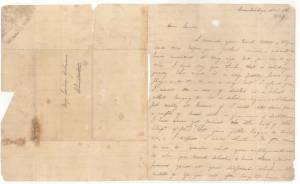1802-1876

Picture Norfolk – NP00016212
Publication prohibited without the permission of Norfolk County Council
Harriet Martineau was born in Norwich on 12 June 1802. She was baptised at the Octagon Unitarian Chapel on 3 September 1802, daughter of Thomas (a cloth manufacturer) and Elizabeth Martineau.
As a child, Harriet had various health problems, including a hearing impairment which led to her becoming her totally deaf by the time she was twenty years old. From 1830 she used an ear trumpet.
Family documents and letters show the Martineau family enjoyed an active social life and were interested in politics and religion, regularly attending the Octagon Chapel.
Harriet’s first published essay appeared in the Unitarian Monthly Repository in 1822. Family tragedy and financial trouble led Harriet to support herself through her writing rather than becoming a governess, including Traditions of Palestine, or, Times of the Saviour (1829), The Rioters (1827), which dealt with machine breaking, and The Turn Out (1829), on wages and strikes.
In 1831, she began work on the successful Illustrations of Political Economy, a series of twenty-three tales in twenty-five parts published monthly from February 1832. This was followed by Poor Laws and Paupers Illustrated (1833), and Illustrations of Taxation (1834).
In late 1832, Martineau moved to London she was celebrated and moved in intellectual and political circles.
Accompanied by Louisa Jeffrey, Harriet went to America on 9 August 1834 to observe the creation of a new society. She travelled from New York through western Massachusetts to Albany and on to Niagara, then to Pennsylvania. After extended stays in Philadelphia, Baltimore, Washington, and Charleston, she travelled across the south to the Mississippi, sailed to Kentucky, where she saw Mammoth cave, and stayed for three weeks in Lexington before ten days in Cincinnati and a return up the Ohio and through Virginia to New York. Without her companion, she toured New England in the autumn of 1835, spent the winter in Boston, and headed west, again to Niagara and on to Detroit and Chicago, returning on the Great Lakes to Cleveland and then back to New York, where she sailed for England on 1 August 1836.

Letter from Harriet Martineau, who was in Cambridge, Mass., to Louise Gilman, Charleston, a schoolgirl. Describes her life and intellectual interests at age 16-20 and deprecating slavery in the USA.
Whilst she was in Cambridge, Massachusetts she corresponded with Louise Gilman a Charleston school girl, (NRO, MC 267/1-3, 684X6) describing the benefits of an education and her hatred of slavery.
Back in London, Harriet published Society in America (1837), considered an historical account of America along with sociological analysis. This was followed with a more conventional account of her travels in Retrospect of Western Travel (1838). She received £900 for the first book, £600 for the second. She also contributed to How to Observe: Morals and Manners (1838) which discussed the
principles of social observation. Her only novel followed a year later Deerbrook (1839)
Along with her major publications at this time, Harriet contributed to the leading reviews of the day and campaigned against slavery and for the legal and economic advancement of women.
In 1838 Harriet health began to deteriorate, and she moved to Newcastle to be near her doctor. After 1842 she was largely confined to her couch; Life in the Sickroom (1844) is account of her experience.
Harriet became fascinated by mesmerism and phrenology. She was ministered to by several practioners and the symptoms of her illness disappeared. She published an account of the cure in six letters to The Athenaeum. Her doctor supposed this was due to her susceptibility and faith in the practice.
She was then able to visit Egypt and the Near East in 1846–7 which was followed by Eastern Life: Present and Past (1848). Her break with religion demonstrated in Letters on the Laws of Man’s Nature and Development (1851) and faith in mesmerism led to alienation from her brother James, a religious philosopher.
In 1845, Harriet Martineau settled in the Lake District, she supervised a 2 acre farm. In 1852 Martineau began writing leading articles for the Daily News in London, and she continued to write for various reviews.
In 1855, Harriet became ill and, expecting her own demise, she wrote her autobiography. She actually lived a further 21 years, passing away on 27 June 1876 at Ambleside.















